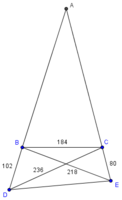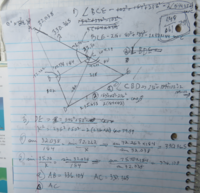allegansveritatem
Full Member
- Joined
- Jan 10, 2018
- Messages
- 962
Yes, you are correct about there not being parallel lines. I was mistaken about similar triangles.It doesn't say any lines are parallel, so I doubt we can identify similar triangles. I'd apply the Law of Cosines to triangles BCD and BCE to find angles ABC and ACB, then focus on triangle ABC to answer the questions.
I was thinking about using the law of cosines--for one thing, this problem comes at the end of a section where the law of cosines is introduced--but I was put off by the statement that we can find what we are looking for without measuring angles and I guess I took that phrase "without measuring angles" to mean "without knowing angles" but of course, that would make the solution impossible. Yes, the nest of triangles in that parallelogram are where the bird of resolution is lurking. I will take that tack and post my results tomorrow. ThanksIt doesn't say any lines are parallel, so I doubt we can identify similar triangles. I'd apply the Law of Cosines to triangles BCD and BCE to find angles ABC and ACB, then focus on triangle ABC to answer the questions.
yes, that business about not needing to measure angles put me off too, but I think the author didn't not express himself fully...he should h ave made it clear that measuring the angles is not necessary provided you know certain dimensions that will allow you to find trigonometrically what the relevant angles are. How else can we solve this without knowing at least a few angles?Yes, you are correct about there not being parallel lines. I was mistaken about similar triangles.
You however are suggesting to find angles but the problems stated not to use angles (that is why I assumed similar triangles)
When you are refreshed come back to the problem and consider similar triangles.
Read carefully. It distinctly says, "without measuring angles", which is entirely different from never using an angle in your work. In the problem, they measured some distances, but no angles, and that's all they mean.Yes, you are correct about there not being parallel lines. I was mistaken about similar triangles.
You however are suggesting to find angles but the problems stated not to use angles (that is why I assumed similar triangles)
right.Read carefully. It distinctly says, "without measuring angles", which is entirely different from never using an angle in your work. In the problem, they measured some distances, but no angles, and that's all they mean.
No, there's no trapezoid either; nothing is stated to be parallel, though the picture looks as if it could be. It's just a quadrilateral.right.
As an aside I want to say that I woke this morning thinking of this problem and it dawned on me I had made a mistake yesterday when I referred to the figure on the near shore in the diagram as a parallelogram. No time to be sure right now but I think I should have said trapezoid.

It is not a trapezoid either. BC and DE are not given to be parallel. So, as given, BCED is just a quadrilateral.right.
As an aside I want to say that I woke this morning thinking of this problem and it dawned on me I had made a mistake yesterday when I referred to the figure on the near shore in the diagram as a parallelogram. No time to be sure right now but I think I should have said trapezoid.
I am so dumb that I didn't know that part of the definition of a trapezoid is that two sides must be parallel. Anyway, I worked on this two hours today and after a few false starts I realized what I needed to do, namely find some angles with the law of cosines and then use the law of sines to get the dimensions on the transriver triangle. Here is what I didNo, there's no trapezoid either; nothing is stated to be parallel, though the picture looks as if it could be. It's just a quadrilateral.
Here is a scale drawing:
View attachment 20070
Just do the trig! Don't overthink it.

I could see that BC was the interface between the partially known and the unknown...but somehow I was fixed on the idea that I needed to know the sides of ABC and then I might be able to find the angle at A and use the law of cosines. I had law of cosines on the brain even though I knew that it was common procedure to use both law of cosines and law of sines together. So I guess I had a plan of some kind after all. It just wasn't a good one. I think it was Mark Twain who said:"It's not what you don't know that hurts you, it's what you know that just ain't so."On important part of strategy is to give some thought early to the "end game", thinking about what might be the last few steps, in order to direct your tactical thinking. Since you are looking for AB and AC, you should expect to work in triangle ABC at the end; and since all the given data are outside the triangle, you might see that the angles at B and C make a good transition. So that would become my initial goal.
By the say, I suggested this strategy in post #3.
